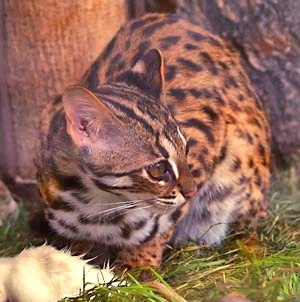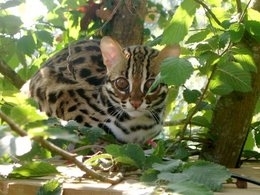Leopard Cat
Contents
Introduction
The Leopard cat (scientific name: prionailurus bengalensis), is a well known and observed felid that inhabits the forests and plains in Southwestern Asia. This cat is usually a solitary cat that sleeps in caves and in hollow trees and hunts mostly on the ground. The Leopard cat has also been recorded to be arboreal and swim. This cat feeds on rodents and other small prey such as lizards, snakes and birds. The Leopard cat is threatened by deforestation of its habitat and being hunted for its coat. This cat is fully protected by laws to mitigate against extinction in the countries it inhabits.
Physical description
| Leopard Cat. Source: Exotic Catz.com |
| Conservation Status |
|
Scientific Classification Kingdom: Animalia (Animals) |
The Leopard cat is similar in size to a house cat only with longer legs. This cat tends to be yellowish-brown in the tropics and greyish-brown in the northern parts of their range. Most often, they are pale tawny on the upper parts and white on the underparts. The body and tail are covered with dark spots, with stripes running down the back of the head. These break into short bands and elongated spots down the middle of the back. The tail has indistinct rings toward its tip. Prionailurus bengalensis measures 60-90 cm (head and body) with a tail length of 28-37 cm and a shoulder height of 20-45 cm. There is sexual dimorphism; males weigh more than females. The eyes are outlined with white stripes that originate at the internal corners and streak across the cheeks.
Behavior and reproduction
Births have been reported to occur in May (breeding from February to March) in Siberia and India, however, populations found inSoutheast Asia breed throughout the year. After a gestation of 65 to 70 days, female Leopard cats have a litter containing one to four young (usually two to three), which are born with their eyes closed. The eyes open at ten days and the young are independent by 18 months. Sometimes males participate in rearing the young. The young reach sexual maturity at eight months of age and may live up to 15 years. The teeth however, are lost at eight to ten years of age.
Distribution
Leopard cats are solitary animals that sleep in small caves or hollow trees. They were thought to be mainly nocturnal, however Rabinowitz (1990) found a Thailand population to have an arrhythmic activity pattern throughout the day. This may be explained by the need to exploit a wide variety of prey. Although this species is mainly terrestrial, it is arboreal to some extent, climbing heights of over 20 meters. In addition, Leopard cats are excellent swimmers, which may explain many offshore populations.They are mainly solitary with average home ranges of 1.5-7.5 square kilometers (core areas of 0.7-2.0 square kilometers) that overlap with other individuals. These large areas are required to provide sufficient hunting area for these carnivores.
Habitat
Besides living in a variety of habitats, Leopard cats usually live near a reliable water source. They are found at high and low altitudes, often in areas of secondary growth. They have even been known to live and breed in agricultural areas such as coffee plantations. This cat occupies the forests and plains areas of Pakistan, Burma, India, Thailand, Vietnam, Malaysia, Indonesia, Philippines, Bangladesh, and small populations have been recorded in China.
Feeding habits
The diet of Prionailurus bengalensis consists mostly of rodents, with the rajah rat comprising the majority of the diet for a Thailand population. However, they also consume small ungulates, hares, insectivores, mustelids, pigs, lizards, snakes, birds, reptiles, insects, eels, fish, crab, and carrion. The diet may also include domestic poultry raided from neighboring human establishments. Grass has also been found in half of all feces collected by Rabinowitz (1990).
Threats
Although Prionailurus bengalensis is common relative to other felids, several island populations are vulnerable due to their small sizes. Even though these cats may seem quite adaptable due to the many habitats in which they live, where forests are threatened, so are Leopard cats. Also, hunting may threaten certain populations of Prionailurus bengalensis. According to Nowell and Jackson (1996), there is national legislation prohibiting the hunting of Prionailurus bengalensis in Bangladesh, Hong Kong, India, Indonesia, Japan, Malaysia, Myanmar, Nepal, Pakistan, Russia, Thailand, and Taiwan. Hunting and trade are regulated in Bhutan, Brunei, China, Philippines, and Vietnam. To safeguard wild populations, captive breeding is being developed for some island populations.
Also according to Nowell and Jackson (1996), the most problematic area for Prionailurus bengalensis is China, where they are heavily hunted for their fur; 400,000 skins were exported annually from 1985-1988. After a European import ban, Japan has taken over as the main importer of fur. To protect the future of Prionailurus bengalensis, the Cat Action Plan has started researching China's Leopard cat harvest, management, and market organization. Ecological field research will also provide data for protected versus harvested populations of Prionailurus bengalensis.
References and further reading
- K.Carlstead, J.L.Brown and J.Seidensticker. 1993. Behavioral and adrenocortical responses to environmental changes in leopard cats (Felis bengalensis). Zoo Biology 12: 321-331.
- Encyclopedia of Life. 2010. Leopard cat Prionailurus bengalensis
- J.Sanderson, S.Sunarto, A.Wilting, C.Driscoll, R.Lorica, J.Ross, A.Hearn, S.Mujkherjee, J.Ahmed Khan, B.Habib, L.Grassman. 2008. Prionailurus bengalensis. IUCN Red List of Threatened Species. Version 2010.4. International Union for Conservation of Nature.
- M.Sunquist and F.Sunquist. 2002. Wild cats of the World. Chicago: University of Chicago Press. pp. 225–232. ISBN 0-226-77999-8.



